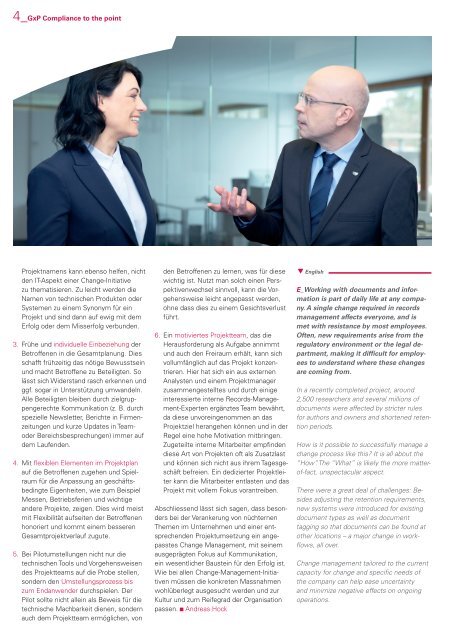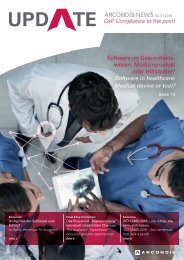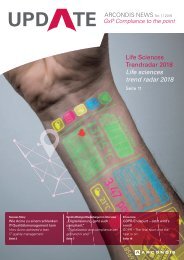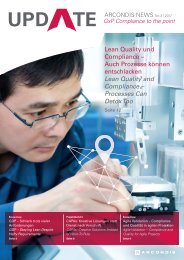ARCONDIS UPDATE No. 02|2018: GxP Compliance to the point
ARCONDIS Kundennewsletter für den Themenbereich Compliance in Medizinprodukteunternehmen
ARCONDIS Kundennewsletter für den Themenbereich Compliance in Medizinprodukteunternehmen
Sie wollen auch ein ePaper? Erhöhen Sie die Reichweite Ihrer Titel.
YUMPU macht aus Druck-PDFs automatisch weboptimierte ePaper, die Google liebt.
4_<strong>GxP</strong> <strong>Compliance</strong> <strong>to</strong> <strong>the</strong> <strong>point</strong> 5<br />
Projektnamens kann ebenso helfen, nicht<br />
den IT-Aspekt einer Change-Initiative<br />
zu <strong>the</strong>matisieren. Zu leicht werden die<br />
Namen von technischen Produkten oder<br />
Systemen zu einem Synonym für ein<br />
Projekt und sind dann auf ewig mit dem<br />
Erfolg oder dem Misserfolg verbunden.<br />
3. Frühe und individuelle Einbeziehung der<br />
Betroffenen in die Gesamtplanung. Dies<br />
schafft frühzeitig das nötige Bewusstsein<br />
und macht Betroffene zu Beteiligten. So<br />
lässt sich Widerstand rasch erkennen und<br />
ggf. sogar in Unterstützung umwandeln.<br />
Alle Beteiligten bleiben durch zielgruppengerechte<br />
Kommunikation (z. B. durch<br />
spezielle Newsletter, Berichte in Firmenzeitungen<br />
und kurze Updates in Teamoder<br />
Bereichsbesprechungen) immer auf<br />
dem Laufenden.<br />
4. Mit flexiblen Elementen im Projektplan<br />
auf die Betroffenen zugehen und Spielraum<br />
für die Anpassung an geschäftsbedingte<br />
Eigenheiten, wie zum Beispiel<br />
Messen, Betriebsferien und wichtige<br />
andere Projekte, zeigen. Dies wird meist<br />
mit Flexibilität aufseiten der Betroffenen<br />
honoriert und kommt einem besseren<br />
Gesamtprojektverlauf zugute.<br />
5. Bei Pilotumstellungen nicht nur die<br />
technischen Tools und Vorgehensweisen<br />
des Projektteams auf die Probe stellen,<br />
sondern den Umstellungsprozess bis<br />
zum Endanwender durchspielen. Der<br />
Pilot sollte nicht allein als Beweis für die<br />
technische Machbarkeit dienen, sondern<br />
auch dem Projektteam ermöglichen, von<br />
den Betroffenen zu lernen, was für diese<br />
wichtig ist. Nutzt man solch einen Perspektivenwechsel<br />
sinnvoll, kann die Vorgehensweise<br />
leicht angepasst werden,<br />
ohne dass dies zu einem Gesichtsverlust<br />
führt.<br />
6. Ein motiviertes Projektteam, das die<br />
Herausforderung als Aufgabe annimmt<br />
und auch den Freiraum erhält, kann sich<br />
vollumfänglich auf das Projekt konzentrieren.<br />
Hier hat sich ein aus externen<br />
Analysten und einem Projektmanager<br />
zusammengestelltes und durch einige<br />
interessierte interne Records-Management-Experten<br />
ergänztes Team bewährt,<br />
da diese unvoreingenommen an das<br />
Projektziel herangehen können und in der<br />
Regel eine hohe Motivation mitbringen.<br />
Zugeteilte interne Mitarbeiter empfinden<br />
diese Art von Projekten oft als Zusatzlast<br />
und können sich nicht aus ihrem Tagesgeschäft<br />
befreien. Ein dedizierter Projektleiter<br />
kann die Mitarbeiter entlasten und das<br />
Projekt mit vollem Fokus vorantreiben.<br />
Abschliessend lässt sich sagen, dass besonders<br />
bei der Verankerung von nüchternen<br />
Themen im Unternehmen und einer entsprechenden<br />
Projektumsetzung ein angepasstes<br />
Change Management, mit seinem<br />
ausgeprägten Fokus auf Kommunikation,<br />
ein wesentlicher Baustein für den Erfolg ist.<br />
Wie bei allen Change-Management-Initiativen<br />
müssen die konkreten Massnahmen<br />
wohlüberlegt ausgesucht werden und zur<br />
Kultur und zum Reifegrad der Organisation<br />
passen. Andreas Hock<br />
English<br />
E_Working with documents and information<br />
is part of daily life at any company.<br />
A single change required in records<br />
management affects everyone, and is<br />
met with resistance by most employees.<br />
Often, new requirements arise from <strong>the</strong><br />
regula<strong>to</strong>ry environment or <strong>the</strong> legal department,<br />
making it difficult for employees<br />
<strong>to</strong> understand where <strong>the</strong>se changes<br />
are coming from.<br />
In a recently completed project, around<br />
2,500 researchers and several millions of<br />
documents were affected by stricter rules<br />
for authors and owners and shortened retention<br />
periods.<br />
How is it possible <strong>to</strong> successfully manage a<br />
change process like this? It is all about <strong>the</strong><br />
“How”. The “What” is likely <strong>the</strong> more matterof-fact,<br />
unspectacular aspect.<br />
There were a great deal of challenges: Besides<br />
adjusting <strong>the</strong> retention requirements,<br />
new systems were introduced for existing<br />
document types as well as document<br />
tagging so that documents can be found at<br />
o<strong>the</strong>r locations – a major change in workflows,<br />
all over.<br />
Change management tailored <strong>to</strong> <strong>the</strong> current<br />
capacity for change and specific needs of<br />
<strong>the</strong> company can help ease uncertainty<br />
and minimize negative effects on ongoing<br />
operations.<br />
In our concrete case, a number of poorly<br />
implemented IT projects resulted in a reluctance<br />
<strong>to</strong> change, and <strong>the</strong> organization found<br />
itself in a tense situation due <strong>to</strong> expectations<br />
coming from research projects in <strong>the</strong>ir final<br />
phases.<br />
The following approach proved successful:<br />
1. Adapt <strong>the</strong> speed of change <strong>to</strong> <strong>the</strong><br />
organization. Many companies are<br />
already reluctant <strong>to</strong> change. Here, it<br />
pays off not <strong>to</strong> follow an ambitious<br />
project plan, but instead <strong>to</strong> give <strong>the</strong><br />
organization more time <strong>to</strong> process<br />
changes. Fewer project resources are<br />
planned over a longer period of time.<br />
2. In communication, it has proven<br />
effective <strong>to</strong> tell a s<strong>to</strong>ry of change,<br />
finding a metaphor such as “going<br />
on a journey” or, in <strong>the</strong> case of our<br />
document migration above, “moving<br />
<strong>to</strong> a new, modern home.” This helps<br />
<strong>to</strong> break away from a purely technical<br />
level and stimulate interest and <strong>the</strong><br />
willingness <strong>to</strong> change among those<br />
affected by <strong>the</strong> change. Selecting an<br />
informal, fresh name can also help<br />
bypass <strong>the</strong> IT aspect of an initiative.<br />
Too often, <strong>the</strong> names of technical<br />
products or systems become synony<br />
mous with a project, and are <strong>the</strong>n<br />
forever associated with success or<br />
failure.<br />
3. Involve those affected in<strong>to</strong> overall<br />
planning early on. This establishes<br />
<strong>the</strong> required level of awareness<br />
and turns <strong>the</strong> “affected” in<strong>to</strong> <strong>the</strong><br />
“involved”. It allows you <strong>to</strong> quickly<br />
identify any resistance and maybe<br />
even transform it in<strong>to</strong> support. With<br />
targeted communication (e.g. special<br />
newsletters, reports in company<br />
magazines and brief updates in team/<br />
department meetings), <strong>the</strong> concerned<br />
parties stay up-<strong>to</strong>-date.<br />
4. Meet those affected halfway with<br />
flexible elements in <strong>the</strong> project plan<br />
and allow for adaptation <strong>to</strong> business<br />
specifics, such as trade fairs, company<br />
holidays and important projects.<br />
<strong>No</strong>rmally, such efforts are rewarded<br />
with flexibility and benefit <strong>the</strong> overall<br />
project.<br />
5. For pilot migrations, you should<br />
not only put <strong>the</strong> technical <strong>to</strong>ols and<br />
methods of <strong>the</strong> project team <strong>to</strong> <strong>the</strong><br />
test, but also go through <strong>the</strong> migration<br />
process right down <strong>to</strong> end users.<br />
The pilot should not serve as <strong>the</strong> only<br />
proof of technical feasibility, but instead<br />
allow <strong>the</strong> project team <strong>to</strong> learn<br />
what is important <strong>to</strong> those affected<br />
directly from <strong>the</strong>ir own mouths.<br />
If you take proper advantage of a<br />
change in perspective, it is easier <strong>to</strong><br />
adapt your approach without losing face.<br />
6. A motivated project team that accepts<br />
<strong>the</strong> challenge as a task and is<br />
given space can concentrate fully on<br />
<strong>the</strong> project. A team of external analysts,<br />
a project manager and internal<br />
records management experts has<br />
proven <strong>to</strong> be a successful combination,<br />
as <strong>the</strong>y can work <strong>to</strong>wards <strong>the</strong><br />
project objective without bias and are<br />
normally highly motivated. Internal<br />
employees assigned <strong>to</strong> <strong>the</strong> task<br />
often find this type of project <strong>to</strong> be<br />
an additional burden, unable <strong>to</strong> get<br />
out of <strong>the</strong>ir normal daily business. A<br />
dedicated project manager can help<br />
relieve employees and put all <strong>the</strong>ir<br />
energy <strong>to</strong>wards driving <strong>the</strong> project<br />
forward.<br />
In conclusion, cus<strong>to</strong>mized change management<br />
with a special focus on communication<br />
is a major success fac<strong>to</strong>r, especially when<br />
introducing matter-of-fact <strong>to</strong>pics within <strong>the</strong><br />
company and realizing projects. As with all<br />
change management initiatives, specific<br />
measures have <strong>to</strong> be carefully considered<br />
and match <strong>the</strong> culture and degree of maturity<br />
of <strong>the</strong> organization. Andreas Hock














